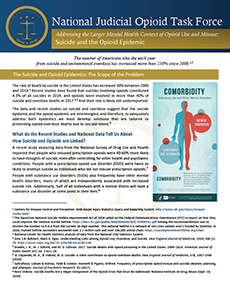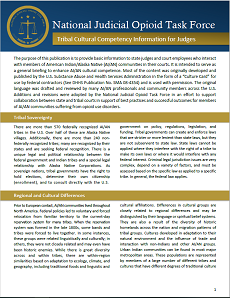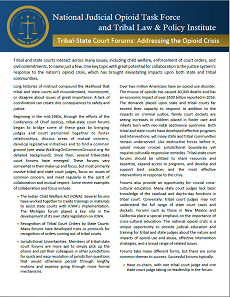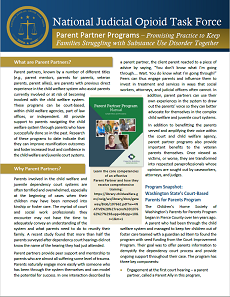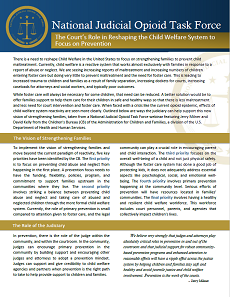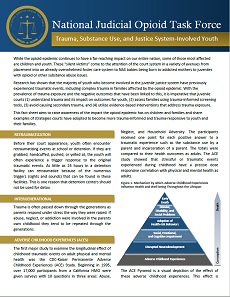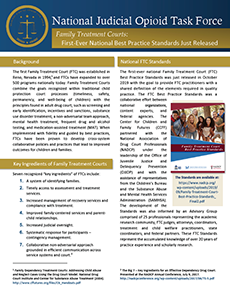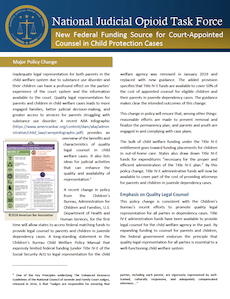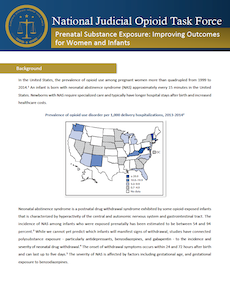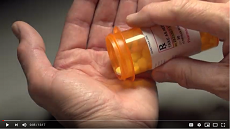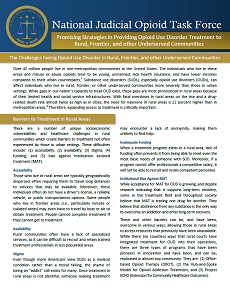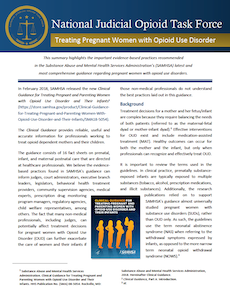American Indians/Alaska Natives
CCJ-COSCA Resolution 1 (2/2019, Conference of Chief Justices and Conference of State Court Administrators): Resolution in support of state/tribal court responses to the opioid crisis.
Tribal Cultural Competency Information for Judges (9/2018, NJOTF): Provides basic information to state judges and court employees who interact with members of American Indian/Alaska Native (AI/AN) communities in their courts. |
Tribal-State Court Forums: Addressing the Opioid Crisis (9/2018, NJOTF): Collaboration between state and tribal courts regarding the opioid crisis. |
Sample Court Transfer Agreement - State and Tribal Courts (9/2018, NJOTF): Document designed and recommended for use in jurisdictions where state court judges – especially those who preside over adult drug court programs – operate in proximity to the location of a Tribal Healing to Wellness Court. |
Joint Jurisdiction Courts: A Manual for Developing Tribal, Local, State & Federal Justice Collaborations, 2nd Edition (6/2018, Oregon Health & Science University, Center for Evidence-based Policy) National Convening of Tribal State Court Forums (6/2016, Tribal Law and Policy Institute) Tribal-State Court Forums: An Annotated Directory (1/2016, Tribal Law and Policy Institute) Promising Strategies: Tribal-State Court Relations (3/2013, Tribal Law and Policy Institute) State and Tribal Courts: Strategies for Bridging the Divide (2011, Center for Court Innovation) American Indian and Alaska Native Culture Card: A Guide to Build Cultural Awareness (3/2009, Substance Abuse and Mental Health Services Administration-SAMHSA) Evidence-Based Practices and Substance Abuse Treatment for Native Americans (Colorado School of Public Health, Centers for American Indian and Alaska Native Health) Telebehavioral Health Center of Excellence (TBHCE) (Indian Health Service) |
Children and Adolescents
Parent Partner Programs – Promising Practice to Keep Families Struggling with Substance Use Disorder Together (4/2019, NJOTF): Discusses how some states are using parent partner programs to improve reunification outcomes and foster increased trust and confidence in the child welfare and juvenile court systems. |
The Court’s Role in Reshaping the Child Welfare System to Focus on Prevention (3/2019, NJOTF): Takeaways from a National Judicial Opioid Task Force webinar featuring Jerry Milner and David Kelly from the Children’s Bureau of the Administration for Children and Families. |
Trauma, Substance Use, and Justice System-Involved Youth (1/2019, NJOTF): Raises awareness of the impact the opioid epidemic has on children and families and shares examples of strategies courts have adopted to become more trauma-informed and trauma-responsive to youth and their families. |
Adolescent Brain (12/2015, National Institute on Drug Abuse): Excellent resource.
Principles of Adolescent Substance Use Disorder Treatment: A Research-Based Guide (1/2014, National Institute on Drug Abuse): Useful for anyone working with youths.
Medication-assisted treatment for youth with opioid use disorder: Current dilemmas and remaining questions (2018, The American Journal of Drug and Alcohol Abuse)
Medication-Assisted Treatment for Adolescents in Specialty Treatment for Opioid Use Disorder (6/2017, Journal of Adolescent Health)
Medication-Assisted Treatment of Adolescents with Opioid Use Disorders (9/2016, Pediatrics, American Academy of Pediatrics Committee on Substance Use and Prevention)
Suicidal Thoughts and Behaviors Among Detained Youth (U.S. Department of Justice, Office of Justice Programs, Office of Juvenile Justice and Delinquency Prevention)
TIP 31: Screening and Assessing Adolescents for Substance Use Disorders (6/2012, Substance Abuse and Mental Health Services Administration-SAMHSA): Guidelines in screening and assessing teens for substance use conditions.
Children of Addicted Parents
Heroin/Other Opioids and Child Welfare (Child Welfare Information Gateway): Resources providing information on the prevalence of opioid use and its impact on children and families involved with child welfare, as well as strategies for treatment and response, including state and local examples.
Substance Use, the Opioid Epidemic and the Child Welfare System: Key Findings from a Mixed Methods Study (3/2018, Assistant Secretary for Planning and Evaluation)
US babies born addicted to opioids has tripled in 15 years, CDC says (8/2016, Ross)
Substance-Exposed Newborns: New Federal Law Raises Some Old Issues (9/2004, National Conference of State Legislatures)
Impacts on Foster Care
Family Treatment Courts: First-Ever National Best Practice Standards Just Released (11/2019, NJOTF) Provides descriptions and provisions of the eight best practice standards released in October 2019. |
New Federal Funding Source for Court-Appointed Counsel in Child Protection Cases (6/2019, NJOTF) Discusses how the new policy for Title IV-E funds promotes quality legal representation for parents and children in child welfare dependency cases. |
Family-Based Residential Treatment: Directory of Residential Substance Use Disorder Treatment Programs for Parents with Children (3/2019, Wilder Research and Volunteers of America with the support of the Annie E. Casey Foundation)
Substance Use, the Opioid Epidemic and the Child Welfare System: Key Findings from a Mixed Methods Study (3/2018, Office of the Assistant Secretary for Planning and Evaluation)
Family Court Tool Kit: Trauma and Child Development (Florida Courts)
Heroin/Other Opioids and Child Welfare (Child Welfare Information Gateway)
Issue Brief, Family First Prevention Services Act (5/2018, National Center for State Courts)
Planning for Safe Care – FDC’s and Opioid Use Disorder (2018, Children and Family Futures)
National Quality Improvement Center on Collaborative Community Court Teams (Children and Family Futures)
The Use of Peers and Other Recovery Specialists in Child Welfare Settings (National Center on Substance Abuse and Child Welfare)
Parent Partner Program Manual: Sample Policies and Procedures (Capacity Building Center for States)
Issue Brief: Supportive Communities – How Can Birth and Foster Parent Partnerships Help Families Reunify? (11/2018, Casey Family Programs)
How does the Parents for Parents program help parents reunify? (8/2018, Casey Family Programs)
Parent Partnership Compendium of Organizations (12/31/2017, National Alliance of Children’s Trust & Prevention Funds and the Birth Parent National Network)
Developing and Sustaining a Parent Partner Program (8/2016 podcast, Administration for Children and Families)
Certified Peer Support Programs (Tennessee Department of Mental Health and Substance Abuse Services)
Combating Rise of Heroin Abuse in Child-Welfare System (10/2013, Rothstein, Smith, & Olivas)
Methamphetamine Addiction, Treatment, and Outcomes: Implications for Child Welfare Workers (4/2006, SAMHSA)
Inmates
Medications to Treat Opioid Use Disorder: How is opioid use disorder treated in the criminal justice system? (6/2018, National Institute on Drug Abuse): Useful to start a discussion on the current state of treatment.
Principles of Drug Abuse Treatment for Criminal Justice Populations - A Research-based Guide (4/2014, National Institute on Drug Abuse)
Jail-Based MAT: Promising Practices, Guidelines and Resources (11/2018, National Commission on Correctional Health Care): Resource to support jail administrators in providing effective treatment for individuals with opioid use disorder.
Joint Public Correctional Policy on the Treatment of Opioid Use Disorders for Justice Involved Individuals (2/2018, American Correctional Association and American Society of Addiction Medicine)
Medication in Prison Associated with Reductions in Fatal Opioid Overdoses After Release (2/2018, National Institute on Drug Abuse): Supports the usefulness/appropriateness of MAT in prisons.
Treating Opioid Addiction in Criminal Justice Settings (12/2017, National Institute on Drug Abuse): Two-page guide that might be useful when meeting with system partners.
Screening and Assessment of Co-occurring Disorders in the Justice System (2/2016, SAMHSA): Evidence-based practices for screening and assessment of adults in the justice system who are living with mental illness, substance use disorders, or both. Could be useful in advocating for creating a screening system, as well as designing such a system.
Practice Profile: Incarceration-based Therapeutic Communities for Adults (2015, National Institute of Justice): Useful for any jurisdiction thinking of creating this sort of a program in their prison. Gives an overview of therapeutic communities.
Principles of Drug Abuse Treatment for Criminal Justice Populations - A Research-Based Guide (4/2014, National Institute on Drug Abuse): Comprehensive and useful.
Program Profile: Forever Free (7/2011, National Institute of Justice): Could be a reference for a task force. Outlines a successful treatment program for women that prison officials might consider.
Program Profile: Prison-Initiated Methadone Maintenance Treatment (6/2011, National Institute of Justice): Could be a reference for a task force. Outlines a successful treatment program that prison officials might consider.
Military
Fighting pain in the U.S. military and veterans (3/2018, National Center for Complementary and Integrative Health): Quick illustration of the greater use of opioids among military personnel after a deployment.
Military (National Institute on Drug Abuse): Helpful information and resources for military members and their families with SUD.
Prenatal Substance Exposure
Prenatal Substance Exposure: Improving Outcomes for Women and Infants (6/2019, NJOTF) Information and guidance regarding how courts can help to improve outcomes for substance exposed infants and their families. |
New Studies Clarify Risk Factors for Neonatal Abstinence Syndrome (1/2019, National Institute on Drug Abuse)
Planning For Safe Care – FDC’s and Opioid Use Disorder (2018, Children and Family Futures, Office of Juvenile Justice and Delinquency Prevention, Family Drug Court Training and Technical Assistance Program)
Prenatal exposure to methadone or buprenorphine: Early childhood developmental outcomes (7/2017, Kaltenbach, et al.)
Opioid Misuse in Pregnant and Postpartum Women Is on the Rise (5/2017, The Pew Charitable Trusts)
Prenatal Drug Use and Newborn Health (2/2015, U.S. Government Accountability Office)
How State Health Departments Can Use the Spectrum of Prevention to Address Neonatal Abstinence Syndrome (2015, Association of State and Territorial Health Officials)
Children Born to Heroin-Addicted Mothers: What’s the Outcome 25 Years Later? (2014, Herranz, Vílchez, Ledo, & Sierra)
Neonatal Abstinence Syndrome: How States Can Help Advance the Knowledge Base for Primary Prevention and Best Practices of Care (2014, Association of State and Territorial Health Officials)
Neonatal Abstinence Syndrome: Treatment and Pediatric Outcomes (2014, Logan, et al.)
Prenatal Substance Abuse: Short- and Long-term Effects on the Exposed Fetus (2013, American Academy of Pediatrics)
Substance-Exposed Infants: State Responses to the Problem (2009, SAMHSA)
Rural Areas
Promising Strategies in Providing Opioid Use Disorder Treatment to Rural, Frontier, and other Underserved Communities (1/2019, NJOTF): Information on barriers to treatment for Opioid Use Disorder in rural areas and what some states are doing to overcome those barriers. |
Rural Health Care Program (2019, Federal Communications Commission)
Your First Stop for Rural Health (Rural Health Information Hub)
Opioid Misuse in Rural America (U.S. Department of Agriculture)
Vulnerable Counties and Jurisdictions Experiencing or At-Risk of Outbreaks (7/2018, Centers for Disease Control and Prevention)
The National Consortium of Telehealth Resource Centers (National Consortium of Telehealth Resource Centers)
Vermont Hub-and-Spoke Model of Care for Opioid Use Disorder (Rural Health Information Hub)
Women and Children
Treating Pregnant Women with Opioid Use Disorder (6/2019, NJOTF) Highlights the important evidence-based practices recommended in the Substance Abuse and Mental Health Services Administration’s (SAMHSA) latest and most comprehensive guidance regarding pregnant women with opioid use disorders. |
Trauma-Informed Practice & the Opioid Crisis: A Discussion Guide for Health Care and Social Service Providers (5/2018, Centre of Excellence for Women's Health)
Treating Opioid Use Disorder During Pregnancy (7/2017, National Institute on Drug Abuse)
A Collaborative Approach to the Treatment of Pregnant Women with Opioid Use Disorders (10/2016, SAMHSA)
Substance Abuse Treatment: Addressing the Specific Needs of Women: Quick Guide for Clinicians Based on TIP 51 (11/2013, SAMHSA)
